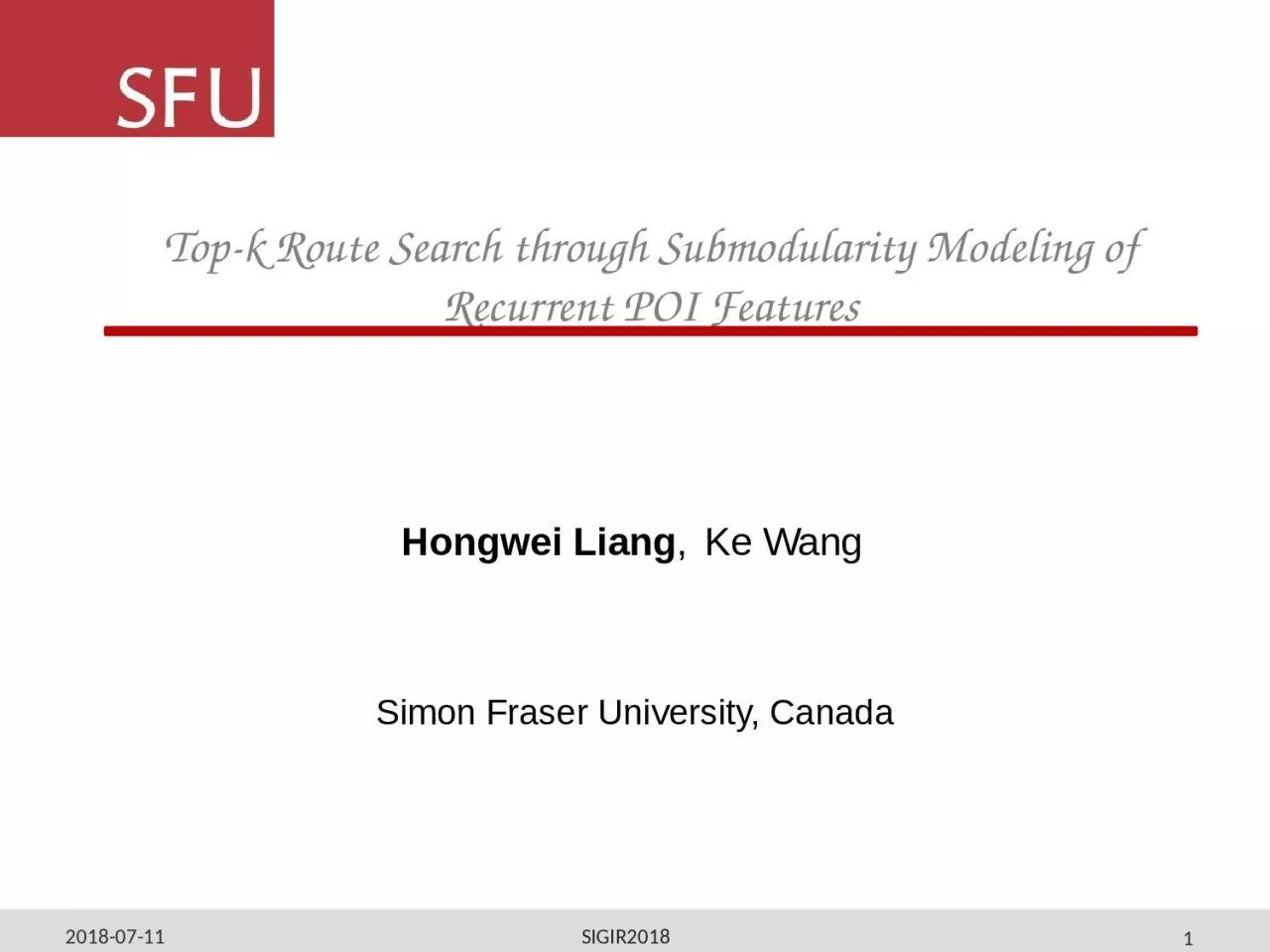

Submodularity Modeling of Recurrent POI Features Hongwei Liang Ke Wang Simon Fraser University Canada 2 Trip Route Recommendation Planning Traveling Apps usually ID: 1010817
Download Presentation The PPT/PDF document "1 Top-k Route Search through" is the property of its rightful owner. Permission is granted to download and print the materials on this web site for personal, non-commercial use only, and to display it on your personal computer provided you do not modify the materials and that you retain all copyright notices contained in the materials. By downloading content from our website, you accept the terms of this agreement.
1. 1Top-k Route Search through Submodularity Modeling of Recurrent POI FeaturesHongwei Liang, Ke Wang Simon Fraser University, Canada
2. 2Trip Route Recommendation/PlanningTraveling Apps: usually only suggest isolated popular POIsTravelersPersonalized interestsNo idea about which places to visit and in which order to visit
3. 3Realistic ConsiderationsLearn Personalized Ratings?Sparse historical rating data on POIsUsers’ PreferencesDynamically change over timeDesire specific features for different tripsTraveling time between POIsImpossible to pre-compute the least traveling time for every pair
4. 4Scenarios: Route Planning with Explicit FeaturesTraveling ScenarioA trip consisting of parks, shopping malls and Japanese restaurants (different degree of preference) before taking the flightEricParkSushiShoppingHome Seeking ScenarioSpend a half day to see open houses that have these features: 3 bdrs, close to schools, big yard. Other Scenarios in Urban Planning, Intelligent transportation, etc3 bdrsClose to schoolsBig yard
5. 5Common Structures and RequirementsPOI MapFeatures with rating on nodesCosts on edges and nodesUser’s RequirementsSource and destination, a travel cost budgetPreferred features and corresponding weights, e.g., park = 0.6, food = 0.4More? How user’s satisfaction changes when visiting more POIs with recurrent feature?
6. 6Quantity vs. VarietyDiminishing Marginal Utility for Recurrent FeaturesDifferent users have various quantity-variety trade-off (personalized diversity requirement)Total accumulated utilityGo go go ! Let’s go!First ParkSecond ParkAnother ParkGo shopping ?Don’t want to see parks any more …
7. 7Problem: Route Search with Personalized Diversity Requirements on POIsGivenA POI map User query QSource, destination, budget, preferred features and weightsFeature aggregation functions indicating a route diversity requirement Goal: top-k routes that maximize a user satisfaction Gain while meeting the requirements in user query QPOIs in a routeweights for each feature haggregate functions for each feature h
8. 8ChallengesModeling Personalized Diversity RequirementsGeneral feature aggregation functions for different diversity requirementsGenerality and Efficiency of Search Algorithm Work nicely for any feature aggregation functions Deal with huge search space and generate high-quality routes in a timely manner
9. 9Modeling Personalized Diversity RequirementsModel Diminishing Marginal Utility by Submodular Set Functions If and , :ABCPark:3Park:5Park:4How to aggregate the ratings for recurrent features? SUM = 3 + 5 + 4 ?Or MAX = 5 ?Neither models diminishing marginal utility well
10. Submodular Aggregation Function Instances 10Power-law based submodular aggregation functionthe rank of POI i on the rating offeature h among the POIs on Ppower-law exponentRating of POI i on feature h = 1Other Submodular Aggregation FunctionsLog utility functionCoverage function
11. 11Framework OverviewOfflineIndex both feature and traveling cost dimensionsOnlineSelect the POI candidates and search for the top-k routesOfflinePOI MapOnlinePOI Candidates RetrievalRetrieve sub-indices According to QuerySelect final POI candidates Routes FindingSearch promising routesTop-k routesUser QueryIndexing (FI and HI)
12. 12Indexing The POI MapOffline Index BuildingFeature index 2-Hop index for least travel cost computationFeature Indexpark: { (v3,1) (v2,0.8) }2-Hop Indexv2: { (v2,0) (v6,4) (v3,5) }v5: { (v5,0) (v3,1) (v4,3) (v6,5) }The least cost from v2 to v5?v3 is the common pivot node u of v2 and v5 that minimize distance(v2, u) + distance(u, v5)Jiang et al., VLDB 2014
13. 13Prefix Based Depth-First Compact States GrowthCompact state : group the routes with same set of POIsEnable Dominance-based Pruning: keep one route for each ending POIIncorporate the idea of DP: all sub-routes are enumerated earlier than super-routes Searching for Optimal Top-k Routes: PACEROnly 3 routes are kept on node 7 {AB} C represents the dominating feasible route among x A B C and x B A C, while the sub-routes x A B and x B A are computed earlier on node 3
14. 14Additional Marginal Gain Upper Bound Pruning A partial route can be extended to many feasible complete routes using the remaining 4 hours budget Utilize the submodularity of Gain to estimate the upper bound (UP) of the following marginal gainPrune if Total accumulatedGainAdded POIsABupper boundCxupper bound ofmarginal gain
15. Directly estimate UP = finding the best subject to a route constraintHard to get the cost of without knowing the order of the POIs in it15More Details of Gain Upper Bound Pruning Approximate “route cost” by “set cost” and convert the problem to finding the best “set of POIs” subject to a set constraintCount half in-edge and half out-edge cost for each POIUse a fast approximation algorithm with a tight online boundxyxyUP is estimated!
16. 16Highlights of PACER GeneralWork efficiently for any submodular Gain functionsSupport pruning for any additional anti-monotone constraints FastEven faster than a state-of-art quasi-polynomial time approximation algorithm for the Orienteering ProblemExtensibleCan naturally derive a much faster heuristic algorithm to deal with queries with loose constraints
17. 17Experiments: A Case Study for Diversity Requirement Singapore dataset: 1625 POIs, 24969 edges, 202 featuresUser query:hours is the diversity parameter of thepower-law basedsubmodular functionPark Museum Restaurant
18. 18Experiments: EfficiencySingapore dataset: budget: threshold on feature ratings: parameter for the power-law based submodular functionAlgorithmDescriptionBFoptimal, brute-forcePACER+1optimal, compact state + dominance pruningPACER+2PACER+1 + gain based upper bound pruning PACER-SCPACER+2 with heuristicsGRgreedy, polynomialAPbaseline approximation
19. 19Q & A ?Thanks all audience and the financial support from SIGIR Travel Award !